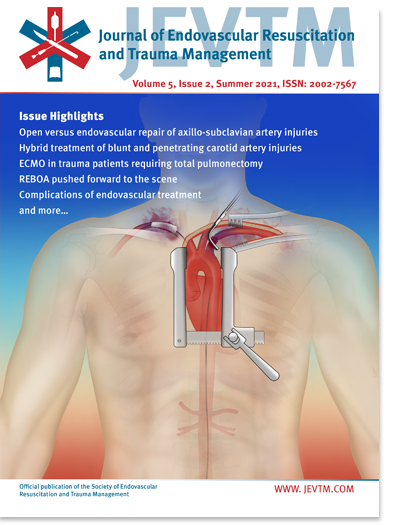Zone III REBOA and the COBRA-OS™: Safety of Inadvertent Iliac Artery Device Deployment
DOI:
https://doi.org/10.26676/jevtm.v5i2.202Keywords:
REBOA, Iliac, SafetyAbstract
Background: Resuscitative Endovascular Balloon Occlusion of the Aorta is an emerging technique in trauma. However, inadvertent iliac artery balloon inflation can lead to complications. This study aims to investigate the safety characteristics of the COBRA-OS™ compared with a 7-Fr commercially available device during purposeful iliac artery balloon overinflation.
Methods: In vitro: the COBRA-OS™ was inflated in explanted porcine iliac arteries and intentionally overinflated until balloon or vessel rupture occurred. In vivo: the COBRA-OS™ and 7-Fr device were deployed in the iliac arteries and intentionally overinflated until rupture of the balloon or blood vessel.
Results: In vitro: an average volume of 1 ml was required for occlusion using the COBRA-OS™ and the mean balloon rupture volume was 32.5 ml. The COBRA-OS™ partially migrated into the aorta in all cases. In vivo: the COBRA-OS™ and 7-Fr device occluded the iliac arteries with a mean volume of 3.5 ml. Overinflation resulted in no iliac ruptures with the COBRA-OS™ (mean balloon rupture volume = 10 ml). Overinflation with the 7-Fr device resulted in 1 iliac rupture at 5 ml. The other two 7-Fr devices had a mean balloon rupture volume of 5 ml. All COBRA-OS™ devices moved partially up into the aorta during inflation while all 7-Fr devices remained in the iliac artery.
Conclusions: The COBRA-OS™ allows for significant overinflation when deployed in the common iliac artery of a porcine model due to its unique design. This ultimately may help to prevent balloon and blood vessel rupture during clinical use; however, further studies are required.
Published
How to Cite
Issue
Section
License
Copyright (c) 2021 Journal of Endovascular Resuscitation and Trauma Management

This work is licensed under a Creative Commons Attribution 4.0 International License.
Authors of content published in the JEVTM retain the copyright to their works.
Articles in the JEVTM are published under the terms of a Creative Commons CC BY 4.0 license, which permits use, downloading, distribution, linking to and reproduction in any medium, provided the original work is properly cited.




